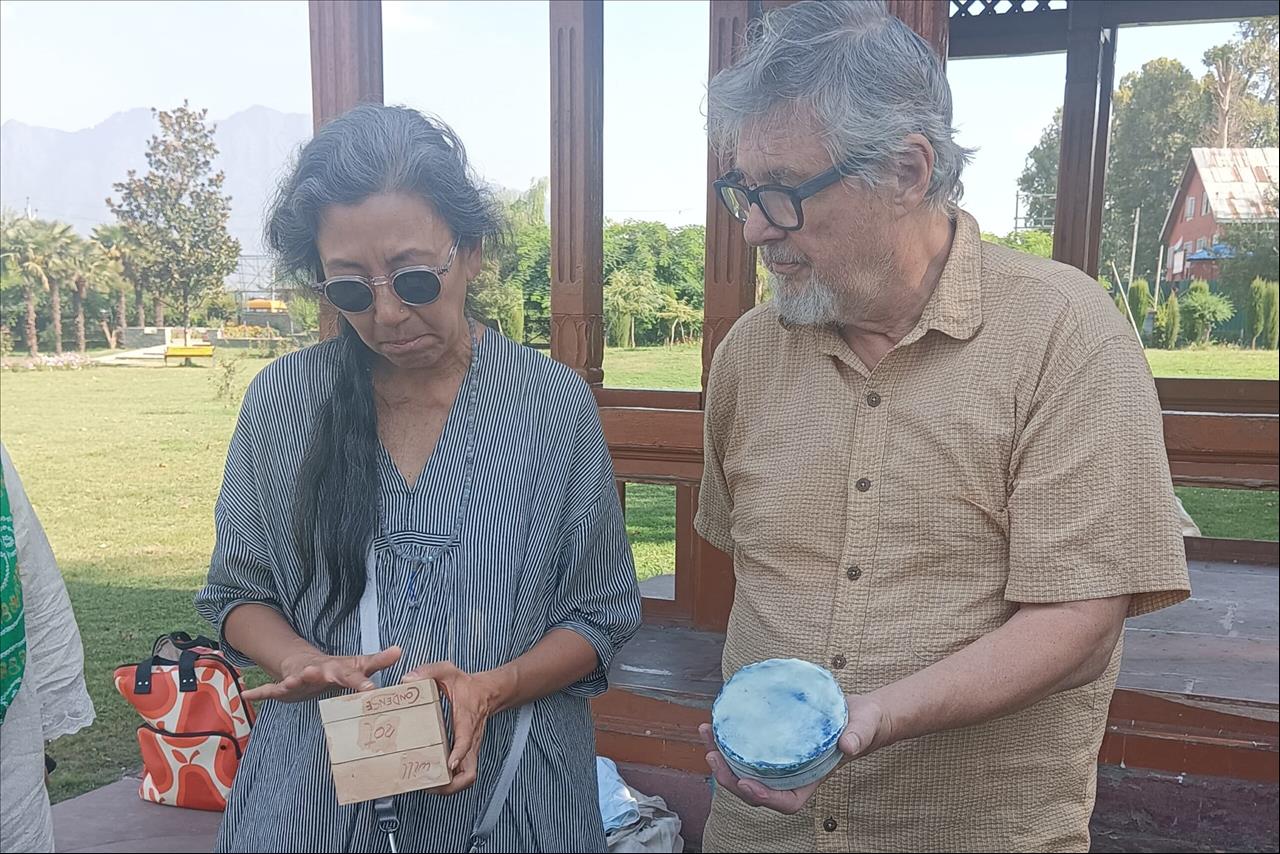Artists From New York Rediscover Kashmir's Creative Spirit
Sono Kuwayama and Bob Holman in Srinagar
By Ilyas Rizvi
I watched the Jhelum rise, its silver waters spilling across the Bund Rajbagh. Rain ran into streets, gardens, and the floating houseboats. Wind rattled the shutters, and the smell of wet earth filled every alley.
Days earlier, Sono Kuwayama and Bob Holman arrived from New York, rain drenching them almost immediately. Soon, phones were useless in a city where signals had vanished. They stepped into the hotel lobby like travelers entering a fragile, unfamiliar world, carrying ideas ready to take shape against the city's restless backdrop.
For a moment, the river, the storm, and the city felt less like obstacles and more like a stage. Everything seemed set for three days of art, conversation, and unexpected connections.
Sono moves between painting, sculpture, and video as if each medium were a language of memory. Bob carries words like instruments, his poetry a bridge between voice and silence. They travel together, creating work that is performative, experimental, alive.
I had been waiting for this visit for months, eager to place their vision against the backdrop of Srinagar's craft, its centuries-old streets, and its living traditions through EdRAAK, the initiative I started a decade ago to revive arts, crafts, and heritage in Kashmir.
The first day began with a walk along the Bund. Jhelum's waters lapped at the streets, houseboats bobbed like gentle boats in a restless sea. The city's sounds – the slap of water, the call of a distant boatman, the hum of a generator – formed a strange orchestra.
Sono Kuwayama showcasing her art at the Bund..
Sono and Bob took it all in, alert and silent, absorbing the rhythm. We moved to British-era showrooms, where wood carvings and papier-mâché lay in layers of dust and reverence. At Mahatta Studio, the century-old photography gallery, Sono traced her fingers across old cameras. Bob recited a few lines, letting them float above the river.
It felt like time bent around us, the past and present folding into a single frame.
We drifted into the lanes of Fateh Kadal, Zaina Kadal, Khanqah e Moula, and Pather Masjid. Here, architecture told stories in three voices: Buddhist simplicity, Hindu detail, Islamic flourish. Painted flowers clung to weathered walls. Carved balconies leaned over narrow streets.
I watched the artists' eyes catch every pattern and carved curve, as if the city itself were a live canvas. Tea came later at Down Town Café. Chai poured onto a dastarkhan, simple yet ceremonial, and conversation moved from art to memory to grief and joy. Every sip tasted like the city itself: layered, warm, and alive.
The second day belonged to the youth. In Bagh e Shagufa, by Nigeen Lake, mostly women from varied backgrounds arrived with notebooks, cameras, brushes. Bob's“Out of Box” exercises and Sono's interactive sessions were sparks thrown into dry tinder.
We used a“Set of Cards” to ask questions beyond routine: What would you say if no one judged? What would you paint if the world paused? Phones were left aside. Kashmiri words shaped the conversations.
Fatima Qadri read her poetry aloud, her voice threading through the autumn wind. Irfan Hussain and Safah Bilal Wadera displayed drawings that trembled between reality and imagination. Marzia Aga, a teenager, premiered Hussain in Kashmir, her camera capturing mourning architecture with the soft echo of oral traditions in the background. Rakeeba Hussain's essay, The Power of Permission, spoke of young women steering social currents. Aabroo Hussain's Pains and Pills drew tears and laughter, mapping grief from humans to animals. Grace Paljor told stories that tethered imagination to tradition.
By afternoon, we walked the lakeway together, and the space seemed suspended in light: art, conversation, laughter, memory, all flowing along the river.
Creative Confluence in Srinagar.
On the final day, elders gathered. At Bukhari Hall, Amar Singh College, we launched Hari Krishna Koul's Complete Short Stories. Later, Abi Guzar, a narrow street turned performance space, held musicians, poets, and artists.
Sono was the only woman among them, observing silently, while Bob performed a poem on Srinagar, composed during our stay. Musician Kifayat Hussain's ghazal wove through the words, grounding poetry in sound.
Participants spoke freely. Safah called the workshops a lifeline. Fatima said they brought hope. Aabroo pointed at mountains, Chinar trees, lakes, skies – nature as a palette, a source of inspiration. Nadiya spoke of calm that art brings, of the slow work of healing. Maria Mir described a space where science and art intersect, where creativity stretched beyond the expected.

Legal Disclaimer:
MENAFN provides the
information “as is” without warranty of any kind. We do not accept
any responsibility or liability for the accuracy, content, images,
videos, licenses, completeness, legality, or reliability of the information
contained in this article. If you have any complaints or copyright
issues related to this article, kindly contact the provider above.
Market Research

- Gas Engine Market Analysis: Strong Growth Projected At 3.9% CAGR Through 2033
- Daytrading Publishes New Study On The Dangers Of AI Tools Used By Traders
- Excellion Finance Launches MAX Yield: A Multi-Chain, Actively Managed Defi Strategy
- United States Lubricants Market Growth Opportunities & Share Dynamics 20252033
- ROVR Releases Open Dataset To Power The Future Of Spatial AI, Robotics, And Autonomous Systems
- Blackrock Becomes The Second-Largest Shareholder Of Freedom Holding Corp.



















Comments
No comment